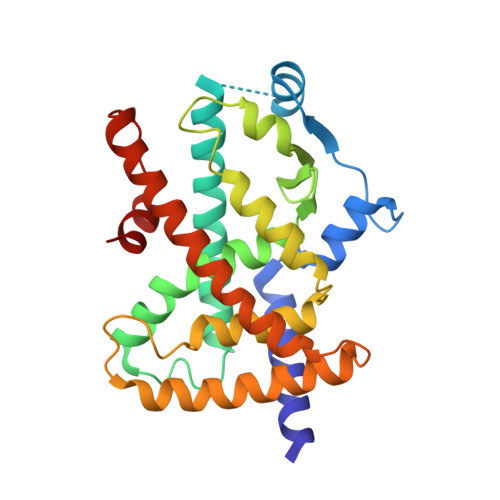Effects of modifications of the linker in a series of phenylpropanoic acid derivatives: Synthesis, evaluation as PPARalpha/gamma dual agonists, and X-ray crystallographic studies.
Casimiro-Garcia, A., Bigge, C.F., Davis, J.A., Padalino, T., Pulaski, J., Ohren, J.F., McConnell, P., Kane, C.D., Royer, L.J., Stevens, K.A., Auerbach, B.J., Collard, W.T., McGregor, C., Fakhoury, S.A., Schaum, R.P., Zhou, H.(2008) Bioorg Med Chem 16: 4883-4907
- PubMed: 18394907
- DOI: https://doi.org/10.1016/j.bmc.2008.03.043
- Primary Citation of Related Structures:
2Q8S - PubMed Abstract:
A new series of alpha-aryl or alpha-heteroarylphenyl propanoic acid derivatives was synthesized that incorporate acetylene-, ethylene-, propyl-, or nitrogen-derived linkers as a replacement of the commonly used ether moiety that joins the central phenyl ring with the lipophilic tail. The effect of these modifications in the binding and activation of PPARalpha and PPARgamma was first evaluated in vitro. Compounds possessing suitable profiles were then evaluated in the ob/ob mouse model of type 2 diabetes. The propylene derivative 40 and the propyl derivative 53 demonstrated robust plasma glucose lowering activity in this model. Compound 53 was also evaluated in male Zucker diabetic fatty rats and was found to achieve normalization of glucose, triglycerides, and insulin levels. An X-ray crystal structure of the complex of 53 with the PPARgamma-ligand-binding domain was obtained and discussed in this report.
Organizational Affiliation:
Department of Chemistry, Pfizer Global Research and Development, Michigan Laboratories, 2800 Plymouth Road, Ann Arbor, MI 48105, USA. agustin.casimiro-garcia@pfizer.com















